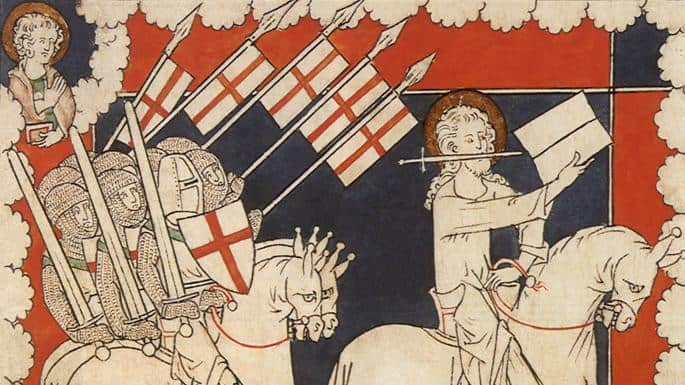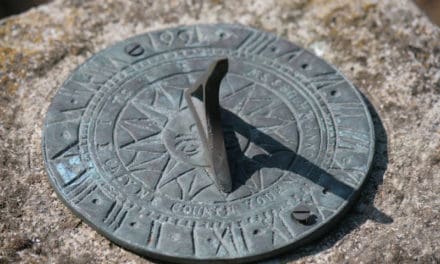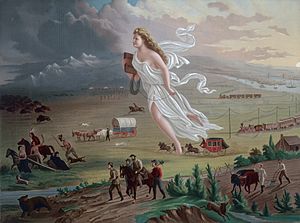This episode of CS is part 3 of our series on The Crusades.
A major result of the First Crusade was a further alienation of the Eastern and Western Churches. The help provided Byzantium by the crusaders were not what The Eastern Emperor Alexius was hoping for.
It also resulted in an even greater alienation of the Muslims than had been in place before. 200 years of crusading rampages across the Eastern Mediterranean permanently poisoned Muslim-Christian relations and ended the spirit of moderate tolerance for Christians living under Muslim rule across a wide swath of territory. The only people who welcomed the Crusaders were a handful of Christian minorities who’d suffered under Byzantine and Muslim rule; the Armenians and Maronites living in Lebanon. The Copts in Egypt saw the Crusades as a calamity. They were now suspected by Muslims of holding Western sympathies while being treated as schismatics by the Western Church. Once the Crusaders took Jerusalem, they banned Copts from making pilgrimage there.
Things really went sour between East and West when the Roman church installed Latin patriarchates in historically Eastern centers at Antioch and Jerusalem. Then, during the 4th Crusade, a Latin patriarch was appointed to the church in Constantinople itself.
To give you an idea of what this would have felt like to the Christian of Constantinople; imagine how Southern Baptists would feel if a Mormon bishop was installed as the President of the Southern Baptist Convention. You get the picture = No Bueno.
Another long-lasting effect of the Crusades was that they weakened the Byzantine Empire and hastened its fall to the Ottoman Turks a couple centuries later. Arab governments were also destabilized leaving them susceptible to invasion by Turks and Mongols.
A significant new development in monastic history was made at this time in the rise of the knightly monastic orders. The first of these was the Knights Templar, founded in 1118 under Hugh de Payens. King Baldwin gave the Templars their name, and from them the idea of fighting for the Temple passed to other orders. Bernard of Clairvaux, although not the author of the Templar rule, as legend has it, did write an influential piece called In Praise of the New Militia of Christ which lauded the new orders of knights.
The Templars were imitated by the Hospitallers, who had an earlier origin as a charitable order. They’d organized in 1050 by merchants from Amalfi living in Jerusalem to protect pilgrims. They provided hospitality and care of the sick, and helped morph the word “hospitality” into “hospital.” Under Gerard in 1120, the Hospitallers gained papal sanction. Gerard’s successor was Raymond de Provence who reorganized the Hospitallers as a military order on the pattern of the Knights Templar. The Hospitallers, also known as the Knights of St. John eventually moved to the islands of Rhodes, then Malta, where they held out in 1565 in a protracted siege against the Turks in one of history’s most significant battles.
Another important military order, the Teutonic Knights arose in 1199, during the 3rd Crusade.
The knightly monastic orders had certain features in common. They viewed warfare as a devotional way of life. The old monastic idea of fighting demons, as seen in the ancient Egyptian desert hermits, evolved into actual combat with people cast as agents of evil. Spiritual warfare became actual battle. Knights and their attendants took the vows similar to other monks. They professed poverty, chastity, and obedience, along with a pledge to defend others by force of arms. While personal poverty was vowed, using violence to secure wealth was deemed proper so it could be used to benefit others, including the order itself. The Templars became an object of envy for their immense wealth.
In studying the relations between Christianity and Islam during the Middle Ages, we should remember there were many peaceful interchanges. Some Christians advocated peaceful missions to Muslims. These peaceful encounters can be seen in the exchange of art. Christians highly valued Muslim metalwork and textiles. Church vestments were often made by Muslim weavers. Such a vestment is located today at Canterbury. It contains Arabic script saying, “Great is Allah, and Muhammad is his prophet.”
On the positive side, if there was anything positive to be gleaned from the Crusades, it did promote a greater sense of unity in Western Europe. Remember that one of the reasons Pope Urban sparked the Crusade was to vent the violent habits of the European nobles who were constantly at each other’s throats. Instead of warring with each other back and forth across Europe, watering its fields with blood, they united to go against infidels “way over there.”
The Crusades also led to increased prestige for the papacy as they were able to mobilize huge numbers of people. The Crusades also stimulated an intellectual revival in Europe as Crusaders returned with new experiences and knowledge from another part of the world.
After the 1st Crusade, over the next 60 years, Jerusalem saw a succession of weak rulers while the Muslims from Damascus to Egypt united under a new dynasty of competent and charismatic leaders. The last of these was Saladin, or, more properly, Salah ad-Din. Founder of the Ayyubid dynasty of Islam, he became caliph in 1174 and set out to retake Jerusalem.
The king of Jerusalem at the time was (and warning: I’m going to butcher this poor guy’s name) Guy de Lusignan. Let’s just call him “Guy.” He led the Crusaders out to a hill on the West of the Sea of Galilee called the Horns of Hattin. Both the Templars and Hospitallers were there in force, and the much vaunted “true cross” was carried by the bishop of Acre, who himself was clad in armor. On July 5, 1187, the decisive battle was fought. The Crusaders were completely routed. 30,000 perished. King Guy, the leaders of the Templars and Hospitallers along with a few other nobles were taken prisoner. Saladin gave them clemency. The fate of the Holy Land was decided.
On Oct. 2, 1187, Saladin entered Jerusalem after it made brave resistance. The generous conditions of surrender were mostly creditable to the chivalry of the Muslim commander. There were no scenes of savage butchery as followed the entry of the Crusaders 90 years before. The people of Jerusalem were given their liberty if they paid a ransom. Europeans and anyone else who wanted to, were allowed to leave. For 40 days the procession of the departing continued. Relics stored in the Church of the Holy Sepulcher were redeemed for the sum of 50,000 bezants. Named after Byzantium where they were the medium of exchange, the bezant was a gold coin of 5 grams.
Thus ended the Latin kingdom of Jerusalem. Since then the worship of Islam has continued on Mount Moriah without interruption. The other European conquests of the 1st Crusade were then in danger from the unending feuds of the Crusaders themselves, and, in spite of the constant flow of recruits and treasure from Europe, they fell easily before Saladin.
He allowed a merely ceremonial Latin ruler to hold the title King of Jerusalem but the last real king was Guy, who was released, then travelled around claiming the title of king but without a court or capital. He eventually settled in Cyprus.
We’ll go into less detail for the rest of the Crusades as we finish them off over the next episode .
The 2nd Crusade was sparked by 2 events; the Fall of the Crusader state of Edessa in Syria and the preaching of Bernard of Clairvaux. And note that the 2nd Crusade took place BEFORE the arrival of Saladin on the scene.
Edessa fell to the Turks in Dec., 1144. They built a fire in a large breach they’d made in the city wall. The fire was so hot it cracked a section of the wall a hundred yards long. When the wall collapsed, the Turks rushed in and unleashed the same kind of brutality the Crusaders had when they conquered Jerusalem.
Pope Eugenius III saw the Turk victory at Edessa as a threat to the continuance of the Crusaders in Palestine and called upon the king of France to march to their relief. The forgiveness of all sins and immediate entrance into heaven were promised to all embarking on a new Crusade. Eugenius summoned Bernard of Clairvaux to leave his abbey and preach the crusade. Bernard was the most famous person of his time and this call by the Pope came at the zenith of his fame. He regarded the Pope’s summons as a call from God.
On Easter in 1146, King Louis of France vowed to lead the Crusade. The Pope’s promise of the remission of sins was dear to him as he was stricken with guilt for having burned a church with 1300 inside. How grand to be able to gain forgiveness by killing more! He assembled a council at Vézelai at which Bernard made such an overpowering impression by his message that all present pressed forward to take up the crusading cause. Bernard was obliged to cut his own robe into small fragments, to give away to all who wanted something of his they could carry to the East. He wrote to Pope Eugenius that the enthusiasm was so great “castles and towns were emptied of their inmates. One man could hardly be found for 7 women, and the women were being everywhere widowed while their husbands were still alive.” Meaning most of the men set off on the Crusade, leaving the population of France with 7 women to every man. Hey – lucky them!
From France, Bernard went to Basel, in modern day Switzerland, then up thru the cities along the Rhine as far as Cologne. As in the 1st Crusade, persecution broke out against the Jews in this area when a monk named Radulph questioned why they needed to go to the Middle East to get rid of God-haters and Christ-killers. There were plenty of them in Europe. Bernard objected vehemently to this. He called for the Church to attempt to win the Jews by discussion and respect, not killing them.
Bernard was THE celebrity of the day and thousands flocked to hear him. Several notable miracles and healings were attributed to him. The German Emperor Konrad III was deeply moved by his preaching and convinced to throw his weight to the Crusade.
Konrad raised an army of 70,000; a tenth of whom were knights. They assembled at Regensburg and proceeded thru Hungary to the Bosporus. All along their route they were less than welcome. Konrad and the Eastern Emperor Manuel where brothers-in-law, but that didn’t keep Manuel from doing his best to wipe out the German force. The guides he provided led the Germans into ambushes and traps then abandoned them in the mountains. When they finally arrived at Nicea, famine, fever and attacks had reduced the force to a tenth is original size.
King Louis set out in the Spring of 1147 and followed the same route Konrad had taken. His queen, Eleanor, famed for her beauty and skill as a leader, along with many other ladies of the French court, accompanied the army. The French met up with what was left of Konrad’s force at Nicea.
The forces then split up into different groups which all reached Acre in 1148. They met King Baldwin III of Jerusalem and pledged to unite their forces in an attempt to conquer Damascus before retaking Edessa. The siege of Damascus was a total failure. The European nobles fell to such in-fighting that their camp fragmented into warring groups. Konrad left for Germany in the Fall of 1148 and Louis returned to France a few months later.
Bernard was humiliated by the failure of the Crusade. He assigned it to the judgment of God for the sins of the Crusaders and Christian world.
A little more about King Louis’s wife Eleanor. Eleanor of Aquitaine was really something. In a world dominated by men, Eleanor’s career was something special. She was one of the wealthiest and most powerful people in Europe during the Middle Ages.
Eleanor succeeded her father as the ruler of Aquitaine and Poitiers at the age of 15. She was then the most eligible bride in Europe. Three months after her accession, she married King Louis VII. As Queen of France, she went on the 2nd Crusade. Then, with it’s defeat and back in France, she got an annulment from Louis on the basis that they were relatives, then married Henry Plantaget, Duke of Normandy and Count of Anjou, who soon became King Henry II of England in 1154. This despite the fact that Henry was an even closer relative than Louis had been and 9 years younger than she. They were married just 8 weeks after her annulment. Over the next 13 years Eleanor bore Henry 8 children: 5 sons, 3 of whom would become king, and 3 daughters. However, Henry and Eleanor eventually became estranged. She was imprisoned between 1173 and 1189 for supporting her son’s revolt against her husband.
Eleanor was widowed in July 1189. Her husband was succeeded by their son, Richard I, known as the Lion-hearted. As soon as he ascended the thrown, Richard had his mother released from prison. Now the queen dowager, Eleanor acted as regent while Richard went on the 3rd Crusade. She survived Richard and lived well into the reign of her youngest son John, known as the worst king in England’s long history. It’s this King John who’s cast as the chief villain in the story of Robin Hood.
The 3rd Crusade is referred to as the Kings’ Crusade due to the European monarchs who participated in it. It was an attempt to reconquer the Holy Land from the Muslims who, under Saladin, had reclaimed the lands the Crusaders took in the 1st Crusade. The 3rd was for the most part successful but fell short of its ultimate goal, the re-conquest of Jerusalem.
When Saladin captured Jerusalem in 1187, the news rocked Europe. The story goes that Pope Urban III was so traumatized, he died of shock. Henry II of England and Philip II of France ended their dispute with each other to lead a new crusade. When Henry died 2 years later, Richard the Lionheart stepped in to lead the English. The elderly Holy Roman Emperor Frederick Barbarossa also responded to the call to arms, and led a massive army across Turkey. Barbarossa drowned while crossing a river in June, 1190 before reaching the Holy Land. His death caused great grief among the German Crusaders. Most were so discouraged they returned home.
After driving the Muslims from the port of Acre, Frederick’s successor Leopold V of Austria and King Philip of France left the Holy Land in August 1191, leaving Richard to carry on by himself. Saladin failed to defeat Richard in any military engagements, and Richard secured several key coastal cities. But the English King realized a conquest of Jerusalem wasn’t possible to his now weakened force and in September of 1192, made a treaty with Saladin by which Jerusalem would remain under Muslim control, but allowed unarmed Christian pilgrims and merchants to visit the city. Richard departed the Holy Land a month later.
The successes of the 3rd Crusade allowed the Crusaders to maintain a considerable kingdom based in Cyprus and along the Syrian coast. Its failure to recapture Jerusalem led to the call for a 4th Crusade 6 years later.
The 3rd Crusade was yet another evidence of the European’s inability to form an effective union against the Muslims. The leaders and nobility of Europe made great promises of unity when they embarked on a Crusade, but the rigors of the journey, along with the imminent prospect of victory saw them more often than not falling out with each other in incessant and petty squabbles.
On Richard’s journey back to England he was seized by the afore mentioned Leopold, duke of Austria, whose enmity he’d incurred in the battle for the city of Joppa. The duke turned his captive over to the Holy Roman Emperor, Henry VI who also had a grudge to settle. The Lionheart was released on the humiliating terms of paying an enormous ransom and consenting to hold his kingdom as a fiefdom of the Empire. It’s this hostage taking of Richard the Lionhearted that forms the backdrop for the tale of Robin Hood.
Saladin died in March, 1193, by far the most famous of the foes of the Crusaders. Christendom has joined with Arab writers in praise of his courage, culture, and the magnanimous manner in which he treated his foes.
Historians debate how many Crusades there were. It wasn’t as though Kings Henry and Philip said, “Hey, let’s make nice and launch the 3rd Crusade.” They didn’t number them as historians have since. History tends to ascribe 9 as the number of Crusades, but then add 2 more by assigning them with names instead of numbers; the Albigenian and the Children’s Crusades, which took place between the 4th and 5th Crusades.
Generally, the 5th thru 9th Crusades are considered lesser armed movements while the first 4 are called the Great Crusades.
We’ll finish with a quick review of the 4th Crusade.
Innocent III became Pope in 1198. He called for the 4th Crusade which was the final blow that forever sundered the Western and Eastern churches, though that was certainly never his aim. In fact, he warned the Crusaders against it.
Pope Innocent’s plan was simply to destroy a Muslim military base in Egypt. The merchants of Venice had promised to supply the Crusaders with ships at a huge discount; one the Crusaders couldn’t pass up. So in the summer of 1202, they arrived in Venice expecting to sail to Egypt. But there was a problem: Only a third of the expected number of warriors showed. And they came up with a little more than half the required sailing fee.
A prince from the East offered to finance the balance under one condition: That the Crusaders sail first to Constantinople, dethrone the current Emperor and hand it over to him. They could then sail on their merry way to Egypt. Pope Innocent forbade this diversion, but no one paid him any attention.
On July 5th, 1203, the Crusaders arrived in the Eastern capital. The people of Constantinople were by now fed up with Europeans meddling in their affairs and formed a counter revolution that swept the current emperor off the throne, but only so they could install their own fiercely anti-Crusader ruler. Being now shut out of his hopes, the would-be emperor who’d paid the Crusaders way to Constantinople refused to pay their way to Egypt, leaving them stranded in increasingly hostile territory.
They were furious. Their leaders decided to try and make the best of it and called for a quick plundering of Constantinople. One of the Crusade chaplains proclaimed; in complete disregard for the Pope’s wishes, “If you rightly intend to conquer this land and bring it under Roman obedience, all who die will partake of the pope’s indulgence.” That was like letting a rabid dog off its chain. For many of the Crusaders, this was not only an excuse to get rich by taking loot, it meant a license to do whatever they pleased in Constantinople.
On Good Friday, 1204, the Crusaders, with red crosses on their tunics, sacked Constantinople. For 3 days, they raped and killed fellow Christians. The city’s statues were hacked to pieces and melted down. The Hagia Sophia was stripped of its golden vessels. A harlot performed sensual dances on the Lord’s Table, singing vile drinking songs. One Eastern writer lamented, “Muslims are merciful compared with these men who bear Christ’s cross on their shoulders.”
Neither the Eastern Empire nor Church ever recovered from those 3 days. For the next 60 years Crusaders from the Roman church ruled what was once the Eastern Empire. The Eastern emperor established a court in exile at Nicaea. Rather than embrace Roman customs, many Eastern Christians fled there. There they remained until 1261, when an Eastern ruler retook Constantinople.





